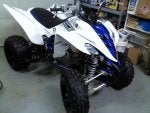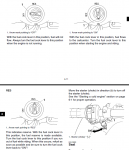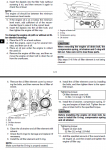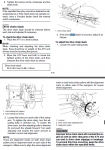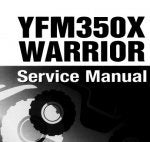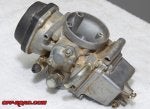The purpose of this post is my general thoughts and ideas surrounding the Raptor 350s I have bought and maintained. I would like to have a discussion regarding some hot topics on the 350 raptors in this was well, what works and what doesnt in regard to owing and working on the 350s.
I buy raptor 350s because of several factors but mostly the reliability and simplicity over the 660s and 700s. Plus 350s go fast enough for me. I call 350s the honda civic of ATVs, easy to work on, easy to get parts, easy to ride and not expensive.
First, history. I have owned four 350s. For numerous reasons I bought and sold my 350s and my forth one is what i always wanted. A 2007 special edition white and blue carbon frame. Very white and very clean with 15 hours on it when I got it. I have a whole process I go through to check them out before riding season and to ensure they are operating within factory specifications and also safe. Basically I go through the entire bike to check it out and replace whats needed.
Here's a short list:
1. clean entire bike thoroughly
2. clean carb and factory jet if no mods are present. yes you can clean and confirm jets are factory sizes. nothing sucks more than a crappy running raptor only to find out the jets were installed wrong sized or whatever. several of my raptors had the wrong jets or clogged jets or dirty carbs. rebuilding the carb isnt hard but there isnt instructions out there clearly. so you have to dig around.
3. I go through the owners manual and service manual to see how things need to be adjusted after initial break in
4. I adjust the intake and exhaust values to the minimal specs. my 350s engines run SUPER quiet with litle ticking or engine noises.
5. I change the oil and oil filters and check the strainer on the bottom. And MAN is it a pain in the ass changing the oil in 350s. The spring on the bottom! No wonder people strip the oil drain plug. The spring makes it very hard to get the plug back into the bottom of the case. Also, the oil filter is odd in that the filter is smashed between the oil filter housing and the cover... meaning when you screw the oil filter cover on the outside, it secures the oil filter inside which feels odd. Just doesnt feel like normal yamaha quality.
6. I check timing and timing chain tension and check and reset the actual tensioner.
7. I clean the chain and drive gears and lube them.
8. I clean and polish the headlight lenses to make them look new.
9. check the brakes and adjust cables and check brake pads and brake disks and brake fluid level.
10. I check for any modifications from the previous owners to make sure they are done correctly and dont damage anything. also slip on exhausts and other things require rejetting so you have to ensure all modifications dont damage something else.
11. check all handlebar mount screws and bolts to ensure they are torqued correctly and safe
12. check battery voltage and fuses and stator voltage for proper electrical system operation
13. check shocks and adjust to your preference
14. read spark plug after several rides to determine mixture setting and operating conditions inside cylinder
15. lube and grease all chassis locations
16. clutch level adjustment and clutch health assessment
Short Raptor 350 Buying Tips
========================================
Theres alot I check out when I buy the 350 but you only have so much time. I call this the 'Raptor 350 Basic Sales Inspection'. You generally look over the bike and check things, start it up, listen to the engine, basically check it out the best you can. If you take 60 minutes OR LONGER talking to the seller and checking out the Raptor the seller often thinks you are a reseller or dealer trying to buy used ATVs (i found this out the hard way LOL).
After I buy the Raptor I check the whole bike in what I call 'Raptor 350 Operational and Safety Check'. The engines seem to take alot of abuse just fine, so if you find a 350 with low hours, minimal wear and tear and good oil (oil to the correct level, looks new, smells new and it not super stinky old oil or smells like gasoline), chances are you will get a GREAT quad for 1800-3500 depending on factors such as region, demand, market, condition, use, service history, title, etc.
Keep in mind the above is a short list of things I do when I buy a Raptor but it can apply to ANY ATV or even a car (i've owned MANY cars too). You may not have the time or resources to PSI test the cylinder when you look to buy a Raptor or ATV. And honestly.. I should.. but dont. I find gently used Raptors from guys who let them sit in garages because they wanted to ride their 660s or 700s more. Im totally good with 350s. Like I said before, they go fast enough for my needs. Im an old dude. Well no.
Seems like most of the problems with 350s are centric around fuel delivery. Basically from the tank through the carb to the jets to the intake valve most people are either running to lean or rich or something is clogged along the fuel delivery path. This leads to backfiring or running hot (lean mix) or hard starting or throttle response issues in mid and open throttle. This is due to something changing the exhaust most commonly and not changing the air or fuel system to match the modification.
Anyway. Your thoughts are welcome here. General ideas or changes you have done on your 350. I would break it up into individual posts but theres too many to cover. These are just all the things I do when I get a 350 to make it run amazing!
I run in the southwest desert so I run yamaha oil filters and 20w-40 wet clutch oil as its always 50+ degrees where I run and 350s seem to run hot.
I run mostly clean stock 350s as I dont buy them to super mod them out. I want a reliable quad to ride and not have to work on every weekend. I want to ride and not be a atv mechanic. I do basic changes. One may be a headlight bulb change from filament H6 to a H6 LED. I dont want to do HID as I dont want to worry about heat or ballast mounting location. I may do a rear taillight filament to LED as well. I also dont run a spark arrestor or baffle as some call it but the baffle is already inside the exhaust pipe itself. Without the spark arrestor it has a meaner sound that costs $0 and most dont have to rejet the carb and it causes no engine issues. Some say it hurts the exhaust valve but few to none have confirmed this.
Anyway. Any thoughts on 350s welcome here.
I buy raptor 350s because of several factors but mostly the reliability and simplicity over the 660s and 700s. Plus 350s go fast enough for me. I call 350s the honda civic of ATVs, easy to work on, easy to get parts, easy to ride and not expensive.
First, history. I have owned four 350s. For numerous reasons I bought and sold my 350s and my forth one is what i always wanted. A 2007 special edition white and blue carbon frame. Very white and very clean with 15 hours on it when I got it. I have a whole process I go through to check them out before riding season and to ensure they are operating within factory specifications and also safe. Basically I go through the entire bike to check it out and replace whats needed.
Here's a short list:
1. clean entire bike thoroughly
2. clean carb and factory jet if no mods are present. yes you can clean and confirm jets are factory sizes. nothing sucks more than a crappy running raptor only to find out the jets were installed wrong sized or whatever. several of my raptors had the wrong jets or clogged jets or dirty carbs. rebuilding the carb isnt hard but there isnt instructions out there clearly. so you have to dig around.
3. I go through the owners manual and service manual to see how things need to be adjusted after initial break in
4. I adjust the intake and exhaust values to the minimal specs. my 350s engines run SUPER quiet with litle ticking or engine noises.
5. I change the oil and oil filters and check the strainer on the bottom. And MAN is it a pain in the ass changing the oil in 350s. The spring on the bottom! No wonder people strip the oil drain plug. The spring makes it very hard to get the plug back into the bottom of the case. Also, the oil filter is odd in that the filter is smashed between the oil filter housing and the cover... meaning when you screw the oil filter cover on the outside, it secures the oil filter inside which feels odd. Just doesnt feel like normal yamaha quality.
6. I check timing and timing chain tension and check and reset the actual tensioner.
7. I clean the chain and drive gears and lube them.
8. I clean and polish the headlight lenses to make them look new.
9. check the brakes and adjust cables and check brake pads and brake disks and brake fluid level.
10. I check for any modifications from the previous owners to make sure they are done correctly and dont damage anything. also slip on exhausts and other things require rejetting so you have to ensure all modifications dont damage something else.
11. check all handlebar mount screws and bolts to ensure they are torqued correctly and safe
12. check battery voltage and fuses and stator voltage for proper electrical system operation
13. check shocks and adjust to your preference
14. read spark plug after several rides to determine mixture setting and operating conditions inside cylinder
15. lube and grease all chassis locations
16. clutch level adjustment and clutch health assessment
Short Raptor 350 Buying Tips
========================================
Theres alot I check out when I buy the 350 but you only have so much time. I call this the 'Raptor 350 Basic Sales Inspection'. You generally look over the bike and check things, start it up, listen to the engine, basically check it out the best you can. If you take 60 minutes OR LONGER talking to the seller and checking out the Raptor the seller often thinks you are a reseller or dealer trying to buy used ATVs (i found this out the hard way LOL).
After I buy the Raptor I check the whole bike in what I call 'Raptor 350 Operational and Safety Check'. The engines seem to take alot of abuse just fine, so if you find a 350 with low hours, minimal wear and tear and good oil (oil to the correct level, looks new, smells new and it not super stinky old oil or smells like gasoline), chances are you will get a GREAT quad for 1800-3500 depending on factors such as region, demand, market, condition, use, service history, title, etc.
Keep in mind the above is a short list of things I do when I buy a Raptor but it can apply to ANY ATV or even a car (i've owned MANY cars too). You may not have the time or resources to PSI test the cylinder when you look to buy a Raptor or ATV. And honestly.. I should.. but dont. I find gently used Raptors from guys who let them sit in garages because they wanted to ride their 660s or 700s more. Im totally good with 350s. Like I said before, they go fast enough for my needs. Im an old dude. Well no.
Seems like most of the problems with 350s are centric around fuel delivery. Basically from the tank through the carb to the jets to the intake valve most people are either running to lean or rich or something is clogged along the fuel delivery path. This leads to backfiring or running hot (lean mix) or hard starting or throttle response issues in mid and open throttle. This is due to something changing the exhaust most commonly and not changing the air or fuel system to match the modification.
Anyway. Your thoughts are welcome here. General ideas or changes you have done on your 350. I would break it up into individual posts but theres too many to cover. These are just all the things I do when I get a 350 to make it run amazing!
I run in the southwest desert so I run yamaha oil filters and 20w-40 wet clutch oil as its always 50+ degrees where I run and 350s seem to run hot.
I run mostly clean stock 350s as I dont buy them to super mod them out. I want a reliable quad to ride and not have to work on every weekend. I want to ride and not be a atv mechanic. I do basic changes. One may be a headlight bulb change from filament H6 to a H6 LED. I dont want to do HID as I dont want to worry about heat or ballast mounting location. I may do a rear taillight filament to LED as well. I also dont run a spark arrestor or baffle as some call it but the baffle is already inside the exhaust pipe itself. Without the spark arrestor it has a meaner sound that costs $0 and most dont have to rejet the carb and it causes no engine issues. Some say it hurts the exhaust valve but few to none have confirmed this.
Anyway. Any thoughts on 350s welcome here.


